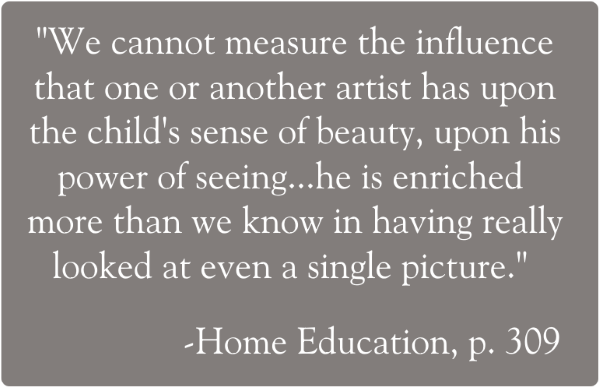
Merry Christmas to all. This re-release of an early episode on picture study and music appreciation begins with a few tips and updates and is appropriate for a feast for the eyes, ears, and heart during this special season. For the not-to-be missed lessons, including art and music is the life-giving energy for the rest of the feast.
Listen Now:

“We cannot measure the influence that one or another artist has upon the child’s sense of beauty, upon his power of seeing, as in a picture, the common sights of life; he is enriched more than we know in having really looked at even a single picture.” (Vol. 1, p. 309)
“They are never copied lest an attempt to copy should lessen a child’s reverence for great work.” (Vol. 6, p. 216)
“A great promise has been given to the world––that its teachers shall not any more be removed. There are always those present with us whom God whispers in the ear, through whom He sends a direct message to the rest. Among these messengers are the great painters who interpret to us some of the meanings of life. To read their messages aright is a thing due from us. But this, like other good gifts, does not come by nature. It is the reward of humble, patient study.” (Vol. 4, p. 102)
“As in a worthy book we leave the author to tell his own tale, so do we trust a picture to tell its tale through the medium the artist gave it.” (Vol. 6, p. 216)
“[F]or though every child cannot be a great performer, all may be taught an intelligent appreciation of the beauties of music, and it is a wicked shame to clang the doors of music, and therefore of endless channels of delight and inspiration, in a child’s face, because we say he has “no ear,” when perhaps his ear has never been trained, or because he never will be able to “play.”” (Miss Pennethorne’s PR Article)
“Hearing should tell us a great many interesting things, but the great and perfect joy which we owe to him is Music.” (Vol. 4, Book I, pp. 30-31)
“Use every chance you get of hearing music (I do not mean only tunes, though these are very nice), and ask whose music has been played, and, by degrees, you will find out that one composer has one sort of thing to say to you, and another speaks other things; these messages of the musicians cannot be put into words, so there is no way of hearing them if we do not train our ear to listen.” (Vol. 4, p. 31)
“Many great men have put their beautiful thoughts, not into books, or pictures, or buildings, but into musical score, to be sung with the voice or played on instruments, and so full are these musical compositions of the minds of their makers, that people who care for music can always tell who has composed the music they hear, even if they have never heard the particular movement before.” (Vol. 4, p. 31)

If you would like to study along with us, here are some passages from The Home Education Series and other Parent’s Review articles that would be helpful for this episode’s topic.
Home Education, Part V, Chapter XXI
School Education, p. 239
Towards a Philosophy of Education, Book I, Chapter X, Section II: f

Benjamin West and His Cat Grimalkin, Marguerite Henry
Stories of Favorite Operas, Clyde Robert Bulla
More Stories of Favorite Operas, Clyde Robert Bulla
Stories of Gilbert and Sullivan Operas, Clyde Robert Bulla
The Ring and the Fire, Clyde Robert Bulla
I, Juan de Pareja, Elizabeth Borton de Trevino
Opal Wheeler’s Composer Biographies
Millet Tilled the Soil, Sybil Deucher
Art for Children series by Ernest Raboff
Elizabeth Ripley’s Artist Biographies
Spiritual Lives of Great Composers, Patrick Kavanaugh
I, Vivaldi, Janice Shefelman
(Contains affiliate links)

Emily’s Picture Study Portfolios
A Humble Place Art Prints
Riverbend Press Artist Prints
Tillberry Table Composer Studies

